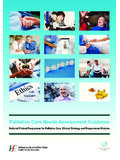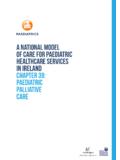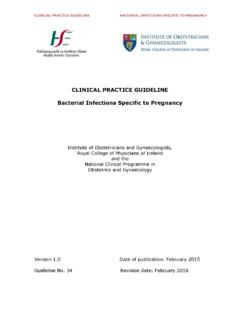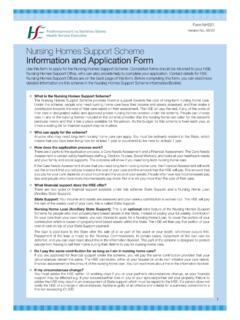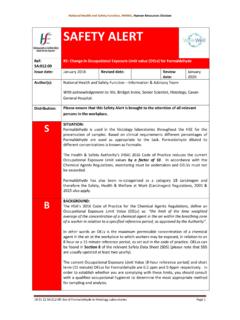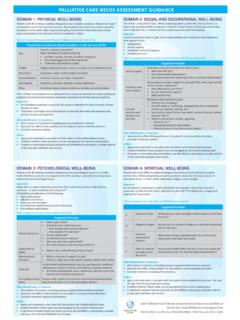Transcription of UL Hospitals Group - Ireland's Health Service
1 UL Hospitals Group Operational Plan 2016 Care Compassion Trust Learning Values We will try to live our values every day and will continue to develop them Vision A healthier Ireland with a high quality Health Service valued by all Mission People in Ireland are supported by Health and social care services to achieve their full potential People in Ireland can access safe, compassionate and quality care when they need it People in Ireland can be confident that we will deliver the best Health outcomes and value through optimising our resources Table of Contents Executive Summary .. 1 INTRODUCTION .. 1 GOVERNANCE .. 2 ORGANISATIONAL CHART .. 3 IMPACT OF DEMOGRAPHICS ON Hospitals .. 4 2015 ACTIVITY .. 5 Emergency Care .. 5 Scheduled Care .. 6 DEVELOPMENTS AND CHALLENGES 2016.
2 7 In Patient and Day Case Activity 2016 .. 7 Risks to the delivery of Acute Hospitals plan within funding available .. 8 CLINICAL STRATEGY AND PROGRAMMES .. 9 Clinical and Integrated Care Programmes .. 9 Integrated Care Programme for Older Persons .. 9 CONCLUSION .. 9 Improving Quality and Reforming Service Delivery .. 10 STRATEGIC PRIORITIES FOR 2016 .. 10 Leadership and Governance for Quality and Safety .. 10 Safe Care .. 11 Effective Care .. 11 Service User Experience .. 11 Health Service REFORM .. 12 Operational Framework Financial Plan .. 13 INTRODUCTION .. 13 EXISTING LEVEL OF Service / COST PRESSURES .. 13 ACTIVITY BASED FUNDING .. 15 Operational Framework Workforce Plan .. 16 INTRODUCTION .. 16 THE WORKFORCE POSITION .. 16 Hospitals Employment Levels .. 16 REDUCING AGENCY AND OVERTIME COSTS.
3 16 2016 DEVELOPMENTS .. 17 PUBLIC Service STABILITY AGREEMENTS 2013-18 .. 17 WORKFORCE PLANNING .. 18 EUROPEAN WORKING TIME DIRECTIVE (EWTD) .. 18 RECRUITMENT .. 18 ATTENDANCE AND ABSENCE MANAGEMENT .. 18 EMPLOYEE ENGAGEMENT .. 19 Health AND SAFETY AT WORK .. 19 Accountability Framework .. 20 INTRODUCTION .. 20 ACCOUNTABILITY FRAMEWORK .. 20 ACCOUNTABILITY LEVELS RELEVANT TO ACUTE HOSPITAL SERVICES .. 21 Service ARRANGEMENTS AND COMPLIANCE .. 21 UL Hospitals Group Key Priorities and Actions to Deliver on Goals in 2016 .. 23 CEO PRIORITIES .. 23 ACUTE HOSPITAL DIVISION PRIORITIES .. 25 UL HOSPITAL Group DIRECTORATE PRIORITIES .. 34 Key Priorities identified as local to the UL Hospital Group 2016 .. 35 NATIONAL CANCER CONTROL PROGRAMME .. 43 Introduction .. 43 UL Hospital Group NCCP Key Priorities and Actions to Deliver on Goals in 2016.
4 43 QUALITY AND ACCESS INDICATORS OF PERFORMANCE .. 46 Appendix 1: Hospital Group Budget .. 50 TABLE 1: NET 2016 BUDGET .. 50 Appendix 2: HR Information .. 51 Appendix 3: Performance Indicator Suite .. 52 SYSTEM-WIDE .. 52 HOSPITAL CARE .. 54 Appendix 4: Capital Infrastructure .. 1 1 Executive Summary Executive Summary Introduction University of Limerick (UL) Hospital Group is comprised of a Group of six Hospitals functioning collectively as a single hospital system in the Mid-West of Ireland. The six sites include: University Hospital Limerick is the Model 4 hospital for the region providing major surgery, cancer treatment and care, emergency department services, as well as a range of other medical, diagnostic and therapy services. It is where all critical care services are located in addition to a 24/7/365 Emergency Department and it is a designated cancer centre.
5 UHL is the second busiest Emergency Department in Ireland with over 57,000 patients annually. Emergency and complex surgeries are only undertaken at UHL. The hospital is the hub for Ennis hospital, Nenagh hospital and St. John s hospital which manage the majority of their local population through their medical assessment units and inpatient beds. Patients who require access to critical and complex care are seen at University Hospital Limerick and either stabilised and transferred to a local Model 2 hospital, namely Ennis or Nenagh or admitted to UHL if required. Croom Hospital is part of the UL Hospitals Group . It is the dedicated orthopaedic hospital for adults and children in the Mid-West region. Croom hospital also accepts the transfer of Orthopaedic patients from UL hospital for post-acute.
6 In addition to Orthopaedic services, Rheumatology and Pain Management services are also provided. University Maternity Hospital, Limerick is the second largest maternity hospital outside Dublin with an average of 5,000 births per year and the sole provider of obstetrical, midwifery and neonatal intensive care to the Mid-West region. It serves Limerick, Clare and Tipperary The maternity hospital also accommodates patients from outside the Mid-west region. These include women from North Cork, Tipperary, North Kerry and areas of Offaly. They also provide tertiary referral for smaller Neonatal Units from outside the region. 2 Executive Summary Governance The Hospitals in Ireland are now organised into seven Hospital Groups (HGs). Each Group Chief Executive has full legal authority to manage the Group delegated to them under the Health Act 2004 in line with National Service Plan (NSP) 2016 and allocated Group budgets.
7 The UL Hospitals Group Operational Plan 2016 is aligned with this Acute Hospitals Division overarching Operational Plan. The Group Chief Executives report to the National Director for Acute Services and are accountable for their planning and performance under the Accountability Framework of the HSE. All targets and performance criteria adopted in the Service plan and the divisional Operational Plan will be reported through this framework. UL Hospitals is governed by an interim Board and an Executive Management Team led by a CEO who reports to the Board. Our services are delivered across the six sites under the leadership of four clinical directorates namely, Medicine Directorate, Perioperative Directorate, Diagnostic Directorate, Maternal and Child Health Directorate. Each Directorate is led by a team of staff bringing Clinical.
8 Managerial and Financial expertise together to provide quality driven safe services, focused on the experience and outcomes for the patient. Professor Niall O Higgins Mr. Seamus Gubbins Professor Don Barry Mr. Maurice Carr Dr. Mary Gray Dr. Sheelah Ryan Mr. Dara Purcell 3 Executive Summary Organisational Chart 4 Executive Summary Impact of Demographics on Hospitals According to 2011 CSO figures, the population of the Mid West Region is 379,327. This is 5% higher than the 2006 reported figures. The biggest increase in population occurred in County Limerick ( ). The population in Clare grew by ( ), and Tipperary also saw an increase ( ). There was a decrease in the population in Limerick City ( ).
9 The Hospital Group serves a socially diverse population from Limerick City which is the most deprived local authority area nationally. In contrast Limerick County is ranked as the eight most affluent County in the Country. The national age profile particularly impacts on emergency services. Life expectancy in Ireland has increased and is above the EU average of years (Source: Eurostat). People are living longer through medical advances, technology along with an increased knowledge and focus on Health and general well-being. The population of over 65s is set to increase by , or 19,400 persons between 2015 and 2016. There will be 2,900 additional persons over 85 years of age in 2016 a increase (CSO, 2011). Population Persons 2006 Persons 2011 Actual change 2006-2011 Percentage change 2006 -2011 Clare 111,950 117,196 6,246 Limerick City 59,790 57,106 -2,684 Limerick County 124,265 134,703 10,438 Tipperary North 66,023 70,322 4,299 Mid-West 362,028 379,327 18,299 Ireland 4,239,848 4,588,252 384,404 Nationally, this equates to 64m of the net 2015 allocation to keep up with the demographic pressure.
10 Clearly model of care changes relating to the frail elderly area and chronic conditions are key to addressing this challenge. However in 2016 the pressure will continue to fall directly upon Hospitals with limited additional financial provision. In addition to this, nationally it is estimated that approximately 525,590 people aged 65 and older have at least one chronic condition. Using population projections, there will be an additional 16,830 people with at least one chronic condition in 2016 and by 2021 there would be a further 94,580 people with at least one chronic condition (Tilda, 2010). It is estimated that the major chronic diseases will increase by 20% by 2021. These include cardiovascular disease, cancer, stroke, respiratory disease and diabetes. These will all increase by between 4% and 5% per annum.
